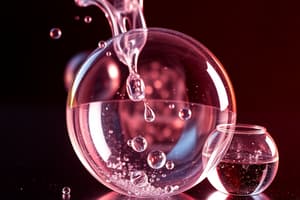Podcast
Questions and Answers
Organic compounds come from living things such as carbohydrates, proteins, fats.
Organic compounds come from living things such as carbohydrates, proteins, fats.
True (A)
This Kind of matter can combine without chemical means. Ex. Milk powder and water
This Kind of matter can combine without chemical means. Ex. Milk powder and water
- Element
- Mixture (correct)
- Compound
- Bases
Match the kind of matter. Hehehehe
Match the kind of matter. Hehehehe
Nitrogen = Element Orange Juice = Mixture Carbohydrates = Organic Compound Na OH (Sodium Hydroxide) = Inorganic compound
Inorganic compounds are made in the lab and can be classified into
Acids, Bases, Salts, Oxides, Alkalides
Inorganic compounds are made in the lab and can be classified into Acids, Bases, Salts, Oxides, Alkalides
Classify this mixture:
It is a one phase system
Particles are uniformly distributed and you can'T see them.
Classify this mixture: It is a one phase system Particles are uniformly distributed and you can'T see them.
Classify this mixture
,Can see different particles
, Two phase system Or more than one phase
, Can identify components
Classify this mixture ,Can see different particles , Two phase system Or more than one phase , Can identify components
Match the separation of mixtures
Match the separation of mixtures
Properties of Matter: Physical properties can be perceived by senses, observed, and measured without changing the components.
These are...
Properties of Matter: Physical properties can be perceived by senses, observed, and measured without changing the components. These are...
________ properties describe the characteristic ability of a substance to react to form new substances; they include its flammability and susceptibility to corrosion. All samples of a pure substance have the same chemical and physical properties.
________ properties describe the characteristic ability of a substance to react to form new substances; they include its flammability and susceptibility to corrosion. All samples of a pure substance have the same chemical and physical properties.
Classify le compounds
*look at the elements *
Classify le compounds *look at the elements *
Flashcards are hidden until you start studying
Study Notes
Organic Compounds
- Derived from living organisms
- Examples: Carbohydrates, proteins, fats
- Can combine without chemical processes, like milk powder and water
Inorganic Compounds
- Created in laboratories
- Classified into: Acids, Bases, Salts, Oxides, Alkalides
Mixture Classification
- One-phase system, uniformly distributed particles, invisible: Homogeneous mixture (e.g., sugar dissolved in water)
- Multiple phases, visible particles, identifiable components: Heterogeneous mixture (e.g., sand and water)
Separation of Mixtures
- Filtration: Separates a solid from a liquid
- Distillation: Separates liquids based on boiling points
- Evaporation: Separates a solid dissolved in a liquid by heating it
- Chromatography: Separates substances based on their different affinities for a stationary and mobile phase
Properties of Matter
- Physical properties: Observable and measurable without altering the substance's composition (e.g., color, density, melting point)
- Chemical properties: Describe a substance's ability to change into new substances (e.g., flammability, corrosion)
Compounds
- Classification: Based on the elements they contain (e.g., water (H₂O) is a compound of hydrogen and oxygen)
Studying That Suits You
Use AI to generate personalized quizzes and flashcards to suit your learning preferences.



